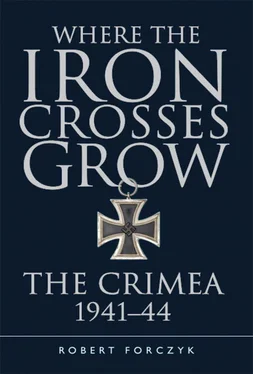Once the Soviets were clearly withdrawing, Manstein reorganized and retasked the component formations of AOK 11: General der Infanterie Hans von Salmuth’s XXX Armeekorps (22. and 72. Infanterie-Divisionen) would clear the Sivash coast and push toward Dzhankoy; Hansen’s battered LIV Armeekorps (50. and 132. Infanterie-Divisionen and Brigade Ziegler) would first clear the port of Yevpatoriya, then head for Sevastopol; and Generalleutnant Hans Graf von Sponeck’s XXXXII Armeekorps (46., 73., and 170. Infanterie-Divisionen) would pursue the 51st Army toward Feodosiya and Kerch. Salmuth formed his own ad hoc motorized unit under Major Robert Pretz, commander of Pionier-Bataillon 22, to lead his pursuit. Kampfgruppe Pretz consisted of pioneers, light flak, and Panzerjägers . Manstein was also provided the Romanian Mountain Corps, but its forces were screening the north side of the Chongar Peninsula and were not in a position to aid a rapid pursuit into the Crimea.
Petrov’s Coastal Army fell back toward Yevpatoriya with the 25th, 95th and 321st Rifle Divisions. There were two main roads heading south from the Perekop: the road to Yevpatoriya and the road to Simferopol. Petrov split his three rifle divisions between these two routes and ordered the 42nd Cavalry Division to act as rearguard and covering force. However, the Soviet units had few motorized vehicles, and initially tried to conduct a slow, fighting withdrawal. One of only four T-34 tanks still operational, commanded by S. Borisov, conducted a single-tank delaying action, pausing to ambush the German advance units before retreating some more. Setting out from Ishun, Brigade Ziegler managed to get past Petrov’s ineffectual cavalry screens and not only get between the two roads on which Petrov’s troops were travelling, but get ahead of them by the end of October 29. Once past Petrov’s troops, Ziegler’s mixed German-Romanian force boldly pushed on to the outskirts of Simferopol on October 30, meeting negligible resistance. The main Soviet command post known as “Red Cave” had already been abandoned. The armored train Voykovets tried to fight a mobile rearguard action but was caught by Luftwaffe bombers in the Simferopol rail yard and knocked out. LIV Armeekorps was also force-marching southward, shoving Petrov’s small rearguard forces out of the way. Petrov continued marching slowly toward Simferopol, but was isolated and in danger of encirclement – if Manstein had had the LSSAH Division, the Coastal Army would have been pinned against the coast and destroyed. Yet German newsreels were already calling this “the victory march in the Crimea,” with the attitude that all that was left were mop-up actions.
Meanwhile, Batov’s broken 51st Army retreated toward the rail intersection at Dzhankoy where they hoped to link up with the 276th Rifle Division, which had been guarding the south side of the Chongar Peninsula. Although Batov tried to put up rearguards, XXX and XXXXII Armeekorps were hard on his heels and simply bowled them over before they could dig in, capturing thousands more Soviet troops in the process. A feeble effort to defend Dzhankoy failed when the 46. Infanterie-Division fought its way into the town on October 30. Aggravating Batov’s situation, Kampfgruppe Pretz was nipping at Batov’s flank along the Sivash, threatening to get ahead of the retreating Soviet divisions. After losing Dzhankoy, Batov’s retreat became a rout. South of Dzhankoy, Colonel Aleksandr I. Danilin and the rest of his staff from the 156th Rifle Division were scooped up by a patrol from the German 170. Infanterie-Division around 1100hrs. Through a Bessarabian interpreter, a German intelligence officer from LIV Armeekorps interrogated Danilin, and in return for assuring him that he would not be executed, was able to extract important details about the direction of the Soviet retreat and the confusion in the Soviet command structure after the defeat at Ishun. [14] Ic, Anlagen z. TB., Interrogation Report dated 30 October 1941, September 22–30 December 1941, LIV Armeekorps, NAM (National Archives Microfilm), series T-314, Roll 1350.
Thereafter, Danilin and his staff disappeared into German captivity, from which few survived.
In Sevastopol, Vice-Admiral Levchenko was out of touch with events at the front, and futilely attempted to direct Petrov and Batov by radio to form defensive positions, unaware that the Germans had already occupied them. Soon, Levchenko lost all radio contact with both armies, and became unable to exercise any kind of command and control over Soviet ground forces in the Crimea. Panic began to set in as the local Soviet military leadership came to realize the extent of the defeat at Ishun and the obvious fact that the Red Army was on the run. Vice-Admiral Oktyabrsky wasted little time, hoisting his flag on the destroyer Boiky in Sevastopol on the evening of October 28 and sailing for the port of Poti, with the battleship Parizhskaya Kommuna and the heavy cruiser Molotov . It was a sauve qui peut moment, like that the French army experienced at Sedan in 1940, with little thought for the consequences. Despite the fact that the Black Sea Fleet had already demonstrated an ability to conduct evacuations under fire at Odessa, which could have saved some of Petrov’s and Batov’s troops who were already cut off by German advances, only a feeble effort was made to save a few troops from Yevpatoriya. Similarly, naval gunfire might have delayed the German advance guard from entering Yevpatoriya and Feodosiya, but aside from two light cruisers and a handful of elderly destroyers, the rest of the fleet was running for cover in the Caucasian ports. Oktyabrsky was finally ordered to return to Sevastopol five days later, but the failure of the fleet to act contributed to the unfolding Soviet debacle in the Crimea.
Nor was there was any unity of command in Sevastopol during the critical days after Ishun. Instead, the newly formed Sevastopol City Defense Committee (Komitet oborana Sevastopolya or KOS) headed by SimferopolCommunist Party boss Boris A. Borisov concerned itself with local defense measures directed by the party, while the Military Council of the Black Sea Fleet (Voyenniy Sovyet Chernomorskogo flota), normally headed by Oktyabrsky, was temporarily headed by his deputy Rear-Admiral Gavrill B. Zhukov, who did little more than proclaim the city to be in a “state of siege.” Yet not everyone in Sevastopol lost their heads. Colonel Pavel P. Gorpishchenko, an iron-willed instructor at the Black Sea Fleet’s Mine Warfare School, formed an ad hoc defense unit from his cadets, then began recruiting sailors from several dry-docked warships in Sevastopol. In short order, Gorpishchenko organized several thousand armed sailors under his command, which was designated as the 1st Naval Infantry Regiment. The 6ft-tall Gorpishchenko was an experienced combat veteran of the Russian Civil War and a charismatic leader who instilled confidence in his sailors-turned-infantrymen. Three other naval infantry battalions, numbered 15, 16, and 17, were formed on October 29 from naval reservists, crewmen from ships under repair, and VVS base personnel. Soon thereafter, 18th and 19th Battalions were formed as well. General-Major Petr A. Morgunov, commander of all the coastal artillery batteries around Sevastopol, did not have the option of running, and put his batteries on full alert to fire on any approaching enemy ground forces.
Just as Oktyabrsky was leaving Sevastopol, the lead elements of Colonel Vladimir L. Vilshansky’s 8th Naval Infantry Brigade were arriving on the cruiser Krasny Krim from Novorossiysk. Vilshansky’s brigade was made up entirely of naval reservists, most of whom had not yet gone through basic training. His brigade had no artillery and very few automatic weapons. Upon arriving at Sevastopol, Vilshansky was met by Rear-Admiral Zhukov, who ordered him to concentrate his brigade at the Mekenzievy Mountain (named after Thomas Mackenzie, who founded Sevastopol in 1783) railroad station 2½ miles north of Sevastopol. By 1600hrs on October 30, Vilshansky had assembled 3,744 sailors from his brigade, and Zhukov ordered him to occupy a position behind the Kacha River near the town of Duvankoi to block the approaches to Sevastopol from the north. [15] Vladimir L. Vilshansky, “Na ognyevom rubezhye” [On the Shooting Range] in Petr Ye. Garmash (ed.), Ognennye dni Sevastopolya [Fiery Days of Sevastopol] (Simferopol: Tavria Publishing, 1978), pp. 40–47.
Zhukov also dispatched 16th and 17th Naval Infantry Battalions and a training battalion north to form a blocking position at the Kacha River bridge to delay Brigade Ziegler from moving down the Simferopol–Sevastopol road. The black-clad sailors marched to these positions during the night of October 30/31 and by November 1 Zhukov had a thin screen of fewer than 6,000 sailors, armed mostly with rifles, protecting the approaches to Sevastopol. However, many of the sailors were equipped with AVS-36 automatic or SVT-38 semi-automatic rifles, which provided more firepower than standard bolt-action rifles. Ziegler’s troops were surprised when they were assembling to attack the Kacha River bridge and came under fire from Coastal Battery No. 30’s 305mm guns; the Soviets claimed that they inflicted very heavy casualties upon the German vanguard, but German records indicate approximately 35–40 casualties and that five trucks were lost. [16] Ia, VII, Beilagenheft zum Kriegstagebuch Nr. 4, “ Gefechtsbericht der Brigade Ziegler, 28.10 – 7.11.41 ,” XXXXII Armeekorps, NAM (National Archives Microfilm), series T-314, Roll 1669, frame 409.
Читать дальше












